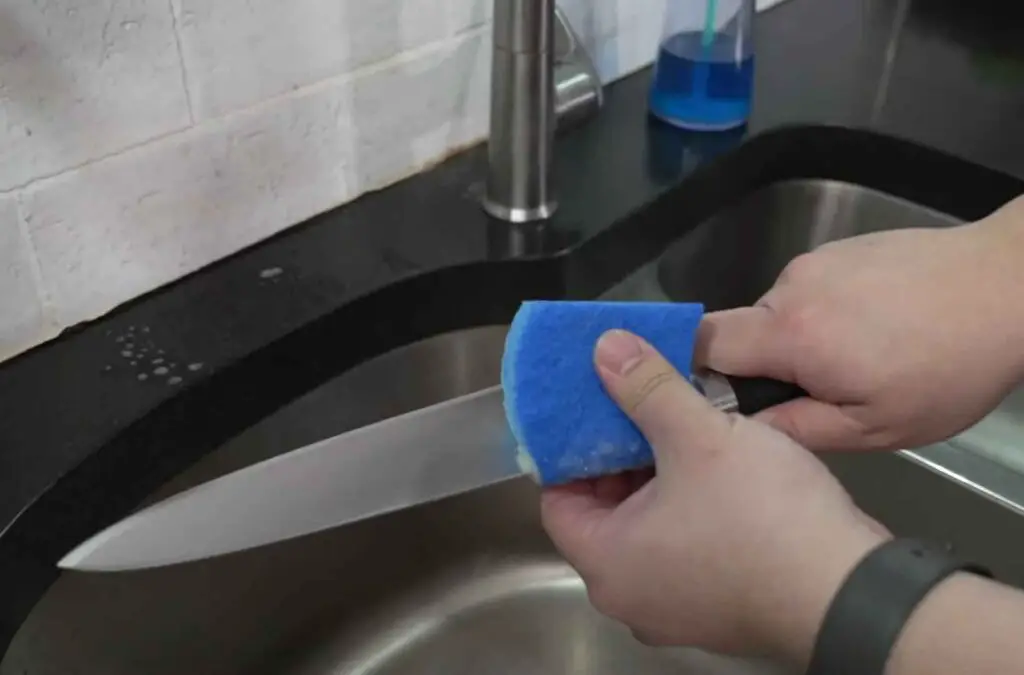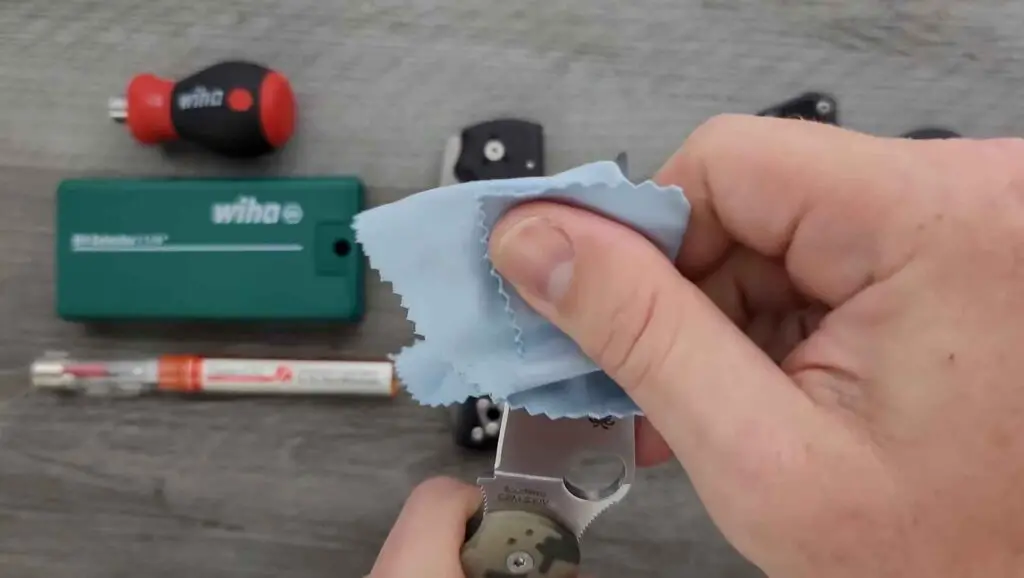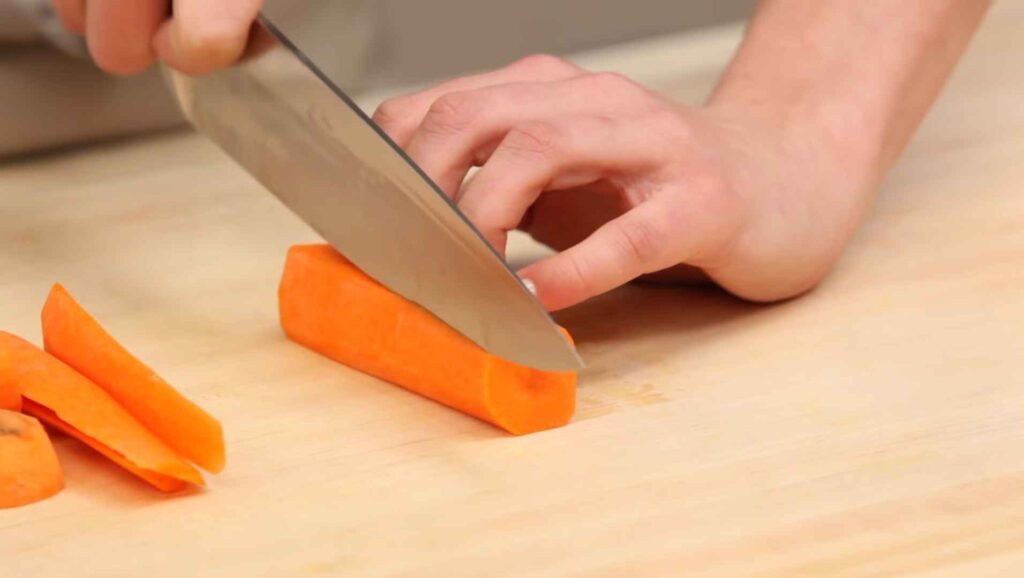It is important to clean and sanitize knives after each use, especially when you have handled raw meat, poultry or fish. Knives must also be washed if they come into contact with other food products such as vegetables or dairy items.
Generally speaking, all knives should be washed in hot soapy water immediately after use, then rinsed thoroughly and dried with a clean cloth or paper towel.
After washing with soap and water it is recommended that the knife is disinfected using either a bleach solution (1 teaspoon of bleach per 1 gallon of warm water) or an alcohol-based sanitizer (at least 60% alcohol).
This will help reduce the risk of cross-contamination from one food item to another.
Knives are an essential kitchen tool and should be kept clean and sanitized for safety reasons. To ensure proper sanitation, knives must be cleaned after every use and then sanitized to kill any lingering bacteria.
A good rule of thumb is to wash the knife with soap and hot water, dry it completely, then soak it in a bleach solution for at least one minute before rinsing it off.
For additional disinfection, consider wiping down your knives with rubbing alcohol or using a UV sanitizer specifically designed for cleaning utensils.

When Must a Knife Be Cleaned And Sanitized Answers?
It is important to ensure that all knives, whether they are kitchen or pocket knives, are cleaned and sanitized regularly.
Knives should be cleaned after every use to prevent food particles from getting trapped between the blade and handle. This can lead to bacteria growth which can be harmful if ingested.
It is also important to sanitize your knives on a regular basis to help reduce the spread of germs and viruses.
Sanitizing involves using hot water combined with bleach, vinegar or other disinfectant solution for a few minutes before rinsing them off completely with clean water and drying thoroughly with a soft cloth.
Doing this will keep your knife blades cleaner and extend their life span by preventing rust buildup over time.
When Must a Knife Be Cleaned And Sanitized After Peeling Potatoes And before Slicing Carrots?
When cooking, it is important to practice good food safety and hygiene. This includes cleaning and sanitizing knives after each use. After peeling potatoes, it is important that you clean and sanitize the knife before slicing carrots or any other vegetable.
The bacteria from the potato can spread onto the carrot if proper sanitation measures are not taken. To properly clean a knife between uses, start by running hot water over both sides of the blade for at least 20 seconds to remove any visible dirt or debris on its surface.
Next, scrub both sides of the blade with soap and warm water using a sponge or brush in order to remove unseen particles of food clinging to its edge.
Finally, rinse all remaining residue with hot water before thoroughly drying with a clean cloth or paper towel. Once this process has been completed, your knife will be ready for use again without risk of transferring harmful bacteria from one type of food to another!
When Should You Clean Your Knife?

A knife is an essential kitchen tool, but it can quickly become dangerous if not properly cared for. Thus, cleaning your knives on a regular basis should be part of any chef’s routine in order to maintain safety and efficiency in the kitchen.
The best time to clean your knife is right after you use it; this will help keep bacteria from growing and prevent rusting.
Start by washing the blade with warm soapy water, and then dry the knife thoroughly with a paper towel or cloth. Additionally, using honing steel (a rod-shaped instrument made of metal) regularly can help sharpen your knives over time and extend their life span.
Finally, make sure to store them safely away from any heat sources such as stoves or ovens that could cause damage to the blades over time.
By following these simple steps on when to clean your knife, you’ll be able to enjoy cooking more efficiently while also keeping yourself safe in the process!
Why Should Knives Be Cleaned After It Has Been Used?

Knives should always be cleaned after use to maintain its sharpness, hygiene and longevity. Since a knife is one of the most used kitchen tools, it’s essential that you keep it in top condition by regularly cleaning it.
Dirt, food particles and other debris build up over time on knives, which can make them dull or difficult to use effectively.
By washing your knives with warm water and mild dish soap shortly after each use you can ensure that they remain clean and free from bacteria buildup which can cause illness if ingested.
Additionally, regular cleaning helps protect the blade from rusting or tarnishing which can reduce its lifespan significantly. Finally, keeping your knives clean also makes them easier to sharpen as the abrasive action won’t have to work against dirt or grime – allowing for a much better result overall!
Food Safety: Keeping Knives Clean
When Must a Knife Be Cleaned And Sanitized Quizlet
In order to reduce the spread of bacteria and other germs, knives should be cleaned and sanitized after every use. This includes washing the knife with warm soapy water, rinsing it off, and then using a kitchen sanitizer on the blade before drying it.
It’s important to take extra care when cleaning knives used for meat or poultry preparation in order to avoid cross-contamination between food products.
When Must a Knife Be Cleaned And Sanitized After 4 Hours of Constant Use
It is important to ensure that knives are cleaned and sanitized regularly, especially when they have been in constant use for more than 4 hours. Washing the blade with warm, soapy water and then disinfecting it with a chemical solution such as bleach or hydrogen peroxide can help prevent the spread of bacteria.
Additionally, it’s important to properly store knives away from food products to avoid cross-contamination.
When Must a Knife Be Cleaned And Sanitized Brainly
A knife must be cleaned and sanitized after every use. This is especially important when working with different types of foods, as it prevents cross-contamination and food poisoning.
Additionally, knives should also be washed in hot soapy water before use to ensure that they are free of any bacteria or germs.
What is the Correct Order of Steps for Cleaning And Sanitizing Utensils by Hand
The correct order of steps for cleaning and sanitizing utensils by hand is as follows:
1) Pre-rinse the utensil with warm water;
2) Apply detergent or soap to the surface and scrub vigorously with a brush or scouring pad;
3) Rinse off all traces of soap from the surface;
4) Sanitize using a solution that’s at least 100 parts per million (ppm) chlorine bleach in hot water, allowing it to air dry on a rack.
Remember to follow up these steps regularly for clean and sanitized utensils.
When Must the Sanitizing Step Occur
Sanitizing surfaces is critical in preventing the spread of bacteria and viruses. The sanitizing step should occur after cleaning, as this will help eliminate all germs from the surface.
Sanitizing should be done with an appropriate solution such as bleach or other approved disinfectants, according to directions provided by the manufacturer.
Make sure that you allow sufficient contact time between your sanitizer and the surface before wiping it down so that any residual germs can be killed off effectively.
Put the Steps for Cleaning And Sanitizing in the Correct Order
When cleaning and sanitizing your home, it’s important to follow the correct order of steps to ensure that all surfaces are properly disinfected.
The best way to do this is by following the CDC guidelines which recommend starting with sweeping or vacuuming any dirt and debris from the surface you’ll be cleaning.
Next, use a detergent solution on hard surfaces like countertops and sinks, then rinse with water before wiping dry with a clean cloth.
Finally, use an EPA-registered disinfectant (or diluted household bleach) to kill germs and bacteria on all surfaces – making sure to read product labels for proper usage instructions. Following these steps in order will help keep your home clean and safe!
What is the Correct Order of Steps for Handwashing
The correct order of steps for handwashing is to wet your hands with clean, running water (warm or cold), turn off the tap, and apply soap.
Next, lather your hands by rubbing them together with the soap. Be sure to scrub all surfaces including the backs of your hands, between your fingers, and under your nails.
Finally rinse your hands thoroughly with clean running water and dry them using a clean towel or air dryer.
When Must the Cleaning Step Occur When Cleaning And Sanitizing in a Three-Compartment Sink
The cleaning step is the most important part of cleaning and sanitizing in a three-compartment sink, and should always be done first. This includes scrubbing the dishes with soap or detergent to remove any food particles and grease, rinsing them off thoroughly with hot water, and then placing them into the cleanest compartment of the sink.
After all items have been washed this way, they can be sanitized by immersing them in hot water containing an approved sanitizer such as chlorine at a temperature of at least 75°C (167°F).
Conclusion
In conclusion, knives must be regularly cleaned and sanitized to ensure a healthy kitchen environment. Properly cleaning and sanitizing your knives is essential for keeping foodborne illnesses at bay. Furthermore, it helps to keep the blades of the knife sharp so that you can use them effectively in cooking.
Regular cleaning also increases the longevity of your knives as they will stay in better condition over time. Therefore it’s important for everyone who uses knives in their kitchen to properly clean and sanitize their knives after each use and before storing them away.